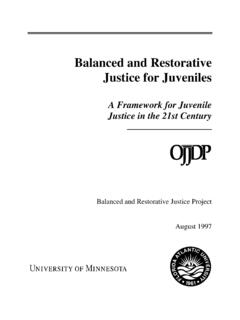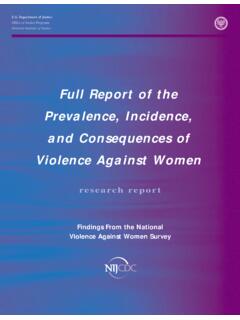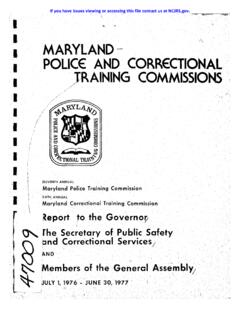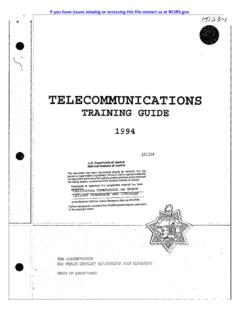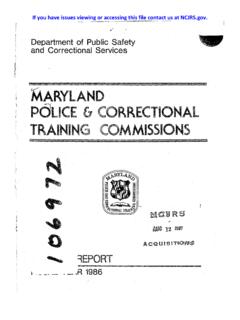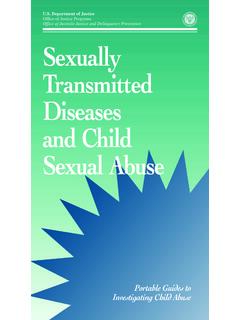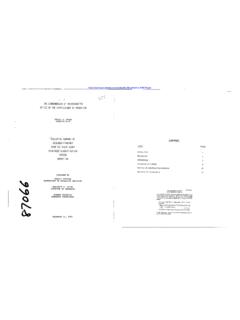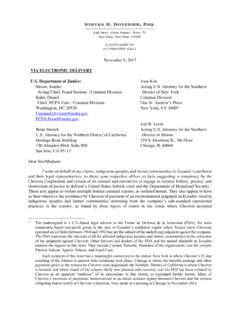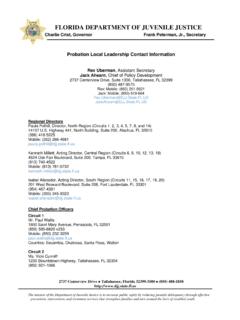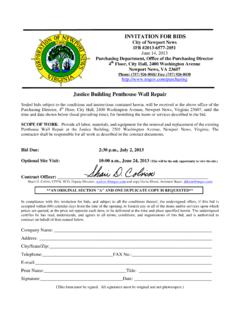Transcription of Vulnerability Assessment of Federal Facilities - NCJRS
1 ~ department of justice 0 Vulnerability Assessment of Federal Facilities June 28, 1995 ,I ~ ~ "~- .. ~~ If you have issues viewing or accessing this file contact us at department of justice United States Marshals Service Vulnerability Assessment OF Federal Facilities Participating Agencies: United States department of justice United States Marshals Service Federal Bureau of Investigation General Services Administration United States department of Defense United States Secret Service United States department of State Social Security Administration Administrative Office of the Courts June 28, 1995 Vulnerability Assessment department of justice United States Marshals Service Contents i Contents.
2 I Introduction The Development of Recommended Minimum Security Standards .. 1-1 The Survey of Existing Conditions .. 1-2 Conclusions and Recommendations .. 1-3 2 Recommended Minimum Security Standards and Application to Security Levels of Federal Facilities Recommended Minimum Security Standards .. 2-1 Perimeter Security .. 2-1 Entry Security .. 2-2 Interior Security .. 2-2 Security Planning .. 2-2 Security Levels for Federal Facilities .. 2-3 Level I .. 2-3 Level II .. 2-4 Level III .. 2-4 Level IV .. 2-4 Level V.
3 2-5 Application of Recommended Minimum Security Standards to Security Levels of Federal Facilities .. 2-5 3 Survey of Existing Security Conditions Study Sample .. 3-1 How the Survey Was Conducted .. 3-1 Findings .. 3-1 Cost Typical Level I Facilities Typical Level II Facilities Typical Level III Facilities Typical Level IV Facilities Typical Level V Facilities Implications , * o , I i * Q , o , i o 3~2 , Q , . i , o , , , , o 3--3.
4 3-3 .. 3-4 .. 3-5 ' ' o " ' , , , I I o ,, i., oe . ,, ..,, i i 3B5 Vulnerability Assessment Contents ii department of justice United States Marshals Service 4 Conclusions and Recommendations 4-1 Conclusions .. Comparison of Typical Facilities and Proposed New Minimum Standards 4-1 Reasons for the Current Security Situation in Federal Facilities .. 4-1 Recommendations .. 4-3 Where Feasible, Bring Each Federal Facility up to The Minimum Standards Recommended For Its Security Level .. 4-3 Establish Building Security Committees.
5 4-3 Reemphasize GSA's Primary Responsibility for Implementing Federal Facility Security .. 4-4 Upgrade the Federal Protective Service .. 4-4 Create An Interagency Security Committee .. 4-5 Funding Recommendations .. 4-7 Additional Recommendations .. 4-7 Next Steps .. 4-7 Appendix A B C D E F G H Vulnerability Assessment Task Force .. A-1 Details of Recommended Security Standards .. B-1 Classification Table .. C-1 Sample of Profile .. : .. D- 1 Compilation of Results of Survey .. E-1 Cost Matrix .. F-1 Role of GSA .. G-1 Federal Agencies with Independent Real Property Authority.
6 H-1 Vulnerability Assessment department of justice United States Marshals Service Introduction 1-1 Introduction The day after the April 19, 1995, bombing of the Alfred P. Murrah Federal Building in Oklahoma City, the President directed the department of justice to assess the Vulnerability of Federal office buildings in the United States, particularly to acts of terrorism and other forms of violence. Because of its expertise in court security, the United States Marshals Service (USMS) coordinated this study. Prior to the study, there were no government-wide standards for security at Federal Facilities , and no central data base of the security currently in place in such Facilities .
7 A national review of the kind called for by the President on April 20 had never before been undertaken. Given the urgency of the task -- a report was to be made in sixty days -- the study proceeded along two tracks at the same time: (1) the development of recommended minimum security standards in light of the changed environment of heightened risk; and (2) the surveying of existing security conditions. The USMS assembled two working groups to accomplish these tasks, a Standards Committee and a Profile Committee. The Development of Recommended Minimum Security Standards The Standards Committee consiste d of security specialists and representatives of components of the department of justice , including the Federal Bureau of Investigation, and of the Secret Service, General Services Administration(GSA), State department , Social Security Administration, and department of Defense.
8 The Committee identified and evaluated the various types of security measures which could be used to counter potential vulnerabilities. The product of the Standards Committee's work was a set of minimum standards that can be applied to various Federal Facilities . The standards cover the subjects of perimeter, entry, and interior security, and security planning. They are set out in Section and Appendix B below. Because of the considerable differences among Federal Facilities and their security needs, the Standards Committee divided Federal holdings into five security levels to determine which minimum standards are appropriate for which security levels.
9 These categories are based on such factors as size, number of employees, use, and required access to the public. The categories Vulnerability Assessment department of justice United States Marshals Service Introduction 1-2 range from Level I (typically, leased space with ten or fewer employees, such as a military recruiting office in a shopping center or a small post office) to Level V (a building such as the Pentagon or CIA headquarters with a large number of employees and a critical national security mission). The security levels are set out in Appendix C.
10 Section shows the recommended minimum security standards applicable to each security level. The Survey of Existing Security Conditions q'he second working group established by the USMS was the Profile Committee. This Committee's task was to survey a broad and representative sample of Federal Facilities to determine their existing security situations, and to identify future security enhancements and costs. There are approximately two million Federal civilian emp~oyec~,' .. t,~'"'t'~,..,.,,, .. ,,er,,'-,, ,--'--.,~' *'~h' ,,,,,~ .. million are housed in GSA space.
